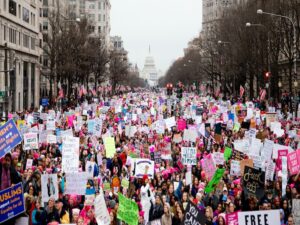Fact is proving stranger than fiction
Winston Smith, the main protagonist of Orwell’s dystopic masterpiece 1984 sums up doublethink. Doublethink, so says Smith, is;
“To know and not to know, to be conscious of complete truthfulness while telling carefully constructed lies..to use logic against logic, to repudiate morality while laying claim to it…to forget whatever it was necessary to forget, then to draw it back into memory again at the moment when it was needed, and then promptly to forget it again, and above all, to apply the same process to the process itself — that was the ultimate subtlety: consciously to induce unconsciousness, and then, once again, to become unconscious of the act of hypnosis you had just performed. Even to understand the word — doublethink — involved the use of doublethink.”
Slogans like War is Peace, Freedom is Slavery, Ignorance is Strength, and 2 + 2 = 5 are examples of how ‘Big Brother’ utilises doublespeak for one aim — to control how people think.
What makes the idea of doublethink so powerful is that it’s a tactic deployed extensively in the real world. The labelling of Israel’s invasion of Gaza as ‘self-defence’ springs to mind as a recent case in point.
But a form of doublespeak that stands alone in its utilisation revolves around the climate crisis. Climate doublespeak has become a powerful weapon that is fundamental to maintaining functioning societies. So what does climate doublespeak look like, and why is its deployment so important in keeping the strings that bind society together? We’ll take a look at five examples of doublespeak that will help reveal its hidden agenda.
1. TBL/ESG/CSR
We enter the murky world of climate doublespeak with a series of synonyms. Triple bottom line (TBL). Corporate social responsibility (CSR). Environmental, Social, Governance (ESG). They’re sustainability terms that seemingly mean everything and precisely nothing at the same time.
Take the TBL for instance. The TBL is a “sustainability framework that examines a company’s social, environmental, and economic impact.” The concept consists of the three p’s; people, planet, and profit. The TBL “aims to measure the financial, social, and environmental performance of the corporation over a period of time.” By internalising the costs of doing business a company can pursue avenues where they remain profitable but in ways that increase social value and decrease environmental impacts. The aim is to reach a sweet point where each component of the TBL is balanced, creating a sustainable company.
The foundations of concepts like CSR and ESG are built around the TBL and the idea that companies can maintain profitability while creating social and environmental value.
These terms have led to a proliferation of businesses embracing sustainability. It’s become the new norm. Corporations now dedicate sections of annual reports (traditionally focused on financial performance) to reporting on sustainability initiatives. We’ve reached a point where companies not embracing a sustainable approach are seen as out of touch.
But this new approach has a clear motivation — to provide a veil of legitimacy that shows companies are making efforts to reduce environmental impacts and ‘give back’ to society, meanwhile, they continue full steam ahead with business as usual.
A recent article that refers to middle management as key to sustainability in businesses sums up this form of doublespeak. How on earth, for instance, can middle management working in companies reduce poverty levels?
2. The fossil fuel industry’s green agenda
Greenwashing is at the heart of climate doublespeak. Greenwashing is all about elevating the green credentials of products or brands, but dig a little deeper, and the perpetrators (usually businesses) continue to operate as usual.
If there were awards for effective greenwashing campaigns, oil companies would receive plenty of nominations.
Shell is focused on becoming net zero by 2050. ExxonMobil claims to be “committed to producing the energy and chemical products that are essential to modern life and economic development, in a way that helps protect people, the environment, and the communities where we operate. This includes mitigating the risks of climate change.”
How exactly does an oil company mitigate the risks of climate change when oil is responsible for climate change? The rather inconvenient truth for oil companies is that an oil company can only become sustainable if it stops selling oil, meaning it would no longer be an oil company. The oil industry is well aware of the precariousness of their situation which is why they lean so heavily on climate doublespeak to justify their existence.
This form of doublespeak is summed up by oil companies embracing the green agenda on one hand, while the other funds climate denial.
The Merchants of Doubt shows how interest groups have created a campaign of misinformation to foster a climate of doubt — going as far as to question whether climate change is happening. By sowing seeds of doubt, they have successfully created a debate, as if climate change isn’t a scientific fact, but an opinion to be contested. As a result, climate denial is still alive and well, particularly in America.
But oil companies don’t stop there. The largest five stock market-listed oil and gas companies spend nearly $200m (£153m) a year lobbying to delay, control, or block policies to tackle climate change — hardly in line with the supposed green agenda.
3. Net zero
Net zero has quickly become the solution we are essentially hedging all of our bets on when it comes to solving the climate crisis. Net zero “means cutting greenhouse gas emissions to as close to zero as possible, with any remaining emissions re-absorbed from the atmosphere.”
At face value, the goal seems reasonable enough. Greenhouse gas emissions are the problem after all, so if we reduce concentrations of greenhouse gases back to pre-industrial levels then we’ll reverse the effects of climate change and everything should be ok.
Right? Hmm.
The important thing to note about the goal is that it doesn’t just involve reducing emissions that stand at over 36 billion tonnes of carbon dioxide a year, to zero. It ALSO requires removing an estimated 1.5 trillion tonnes of historical emissions from the atmosphere.
There are so many issues with the goal, that it would require a book to do it justice, but we’ll briefly focus on one.
The IPCC has calculated that to have a 50 percent chance of restricting global warming to less than 1.5°C, the total cumulative CO2 emissions released into the atmosphere since 1850 must be kept below 2,900 billion tonnes.
There were 2,400 billion tonnes of emissions between 1850 and 2019, with 42 percent of that total occurring between 1990 and 2019. This means from 2020, the maximum available carbon budget remaining is 500 billion tonnes. The remaining budget increases to 1,150 billion tonnes for a 67 percent chance of restricting warming to 2°C.
Plenty of countries have made net zero commitments, so how are pledges translating into actions?
Current pledges will see 1,044 billion tonnes of CO2 emissions between 2021–2050, and this figure excludes emissions from other sources. Many scientists argue forests are close to tipping points. Should this be the case, the Amazon could release 90 billion tonnes of CO2, and boreal forests 110 billion tonnes, which would wipe out any hopes of restricting global warming to 2°C.
The facts are in plain sight, net zero is never going to happen in the timeframe that’s required unless there is a profound and radical social transformation. But the goal remains a vital piece of the climate doublespeak narrative.
4. Decreasing emissions while increasing prosperity
Here’s another key piece of climate doublespeak that seems entirely reasonable and logical. Obviously, we want prosperity to increase, or at the very least to be maintained. We also want to decrease emissions for reasons already outlined.
But should you see this goal (or a variation), alarm bells should be ringing.
It’s an important line of thinking that’s interwoven into pretty much every piece of doublespeak because the suggestion is that high and rising living standards aren’t a problem. The problem is the emissions that are currently intertwined with those living standards.
All we need to do is untwine the emissions that result from the production of all of the goods and services we consume (the stuff that provides high living standards) and we can continue to create prosperity in a sustainable way. That is, in ways that don’t impact the environment negatively.
5. Green growth fed by sustainable consumption
Prosperity, prosperity, prosperity — it’s what this all boils down to. Prosperity for who, though? Now, that, is, the, question.
Increasing prosperity is important because so many people remain in poverty. Obviously, poverty is no picnic, so we can’t create a sustainable world if it means leaving the poor behind. That’s why economic growth is still so important to development.
Ever since the industrial revolution growth has been vital as a means of wealth creation. More wealth translates into higher incomes. Higher incomes mean people have more money to buy more consumable goods. Higher incomes then are what translate into increasing prosperity, increasing well-being, and ultimately increasing happiness.
That’s why the sustainable development goals (SDGs) are important. The goals “recognise that ending poverty and other deprivations must go hand-in-hand with strategies that improve health and education, reduce inequality, and spur economic growth — all while tackling climate change and working to preserve our oceans and forests.”
The SDGs appear to offer a powerful vision of a sustainable world, with each goal broken down into targets for how to achieve it. But when you look at the goals as a system, achieving some would require undermining others. Goal 8, for example, is to Promote sustained, inclusive, and sustainable economic growth, full and productive employment, and decent work for all; Goal 12 is to ensure sustainable consumption and production patterns.
But then Goal 10 — Reduce inequality within and among countries, illustrates a conflict of interests interwoven within the goals. Target 10.1 is to Progressively achieve and sustain income growth of the bottom 40 percent of the population at a rate higher than the national average.
Tim Jackson’s Prosperity without Growth gives a sense of just how unfeasible this target is. He imagines a scenario where creating a just world is taken seriously, and global incomes converge by 2050. For that to happen, if rich countries grow at two percent each year, middle-income countries would need to grow around 7.6 percent each year, and low-income countries by almost 12 percent. In this hypothetical world, that would mean that by 2050 the global economy will be 11 times bigger than in 2016. Beyond 2050, if incomes continue increasing by two percent each year, the economy will be 30 times larger by the end of the century.
That’s why the SDGs focus on green growth fed by sustainable consumption. It’s not entirely clear what these terms mean. In fact, green growth appears to be an oxymoron.
And here is where we ultimately get to the heart of our climate doublespeak agenda.
The hidden agenda
Economic growth has become the secular religion of modern society. So important is growth to functioning societies that should economies contract it leads to crises that could turn into recession and ultimately depression.
So what’s the problem with economic growth?
Well, since the end of the Second World War, there has been an explosion in economic activity. Some have labelled it The Great Acceleration. That acceleration has seen exponential increases in, well everything. From white goods to automobiles, from telecommunications to flights, from fertilisers to water use.
We’ve become masters in increasing productivity. That’s created a lot more wealth, for a lot more people. And lots of us, not all, but lots of people, have reaped the benefits.
But these exponential increases don’t come out of thin air. To make more stuff you need more stuff — that stuff comes from the natural world. You also need energy to make all of the stuff — that energy comes from fossil fuels. The result of all of this activity is the global economy has become big, like, really, really big. So big, that we use the resources of 1.7 earths.
You don’t need me to tell you there is only one Earth, so this is a big deal. When any species exceeds the regenerative capacity of its environment (which is exactly what we’ve done) you have yourself a rather large problem.
And the thing about a society designed and dependent on never-ending growth is that we must continue this expansion, forever, apparently. That’s why terms like green growth have proliferated. The idea is that we can continue increasing output but in ways where we decouple any impacts of doing so from the products and services being produced. Sound impossible? Yeah, that’s because it is.
So how do we avert catastrophe? Well, the only way is to decrease the size of the economy. But, that is quite literally the last thing we will ever do. We’ve got ourselves in quite the pickle, haven’t we?
Interwoven in that pickle is a pretty stark reality. The thing that can’t be sustained is high living standards. The idea that the economy will need to be 30 times larger by 2100 makes that plain obvious. But in our little slice of reality, we can’t see the economy getting larger. We can’t see billions of people locked into the consumer society. We can’t see the billions of people that dream of a better life. And so we crack on, pursuing our own dreams.
When looking at the stakes it’s no wonder climate doublespeak is so rife. A way of life is quite literally on the line. So you can bet your bottom dollar that we’ll continue to behave as we always have because the idea the economy could be organised in any other way is unthinkable. Something will eventually have to give. Looking at the future of catastrophic impacts we’re moving towards, that something appears to be the environmental conditions we depend on for life itself. Until then, we’ll use logic against logic. We’ll tell carefully constructed lies. We’ll forget whatever it is necessary to forget — all to control a narrative that no one dares accept.



